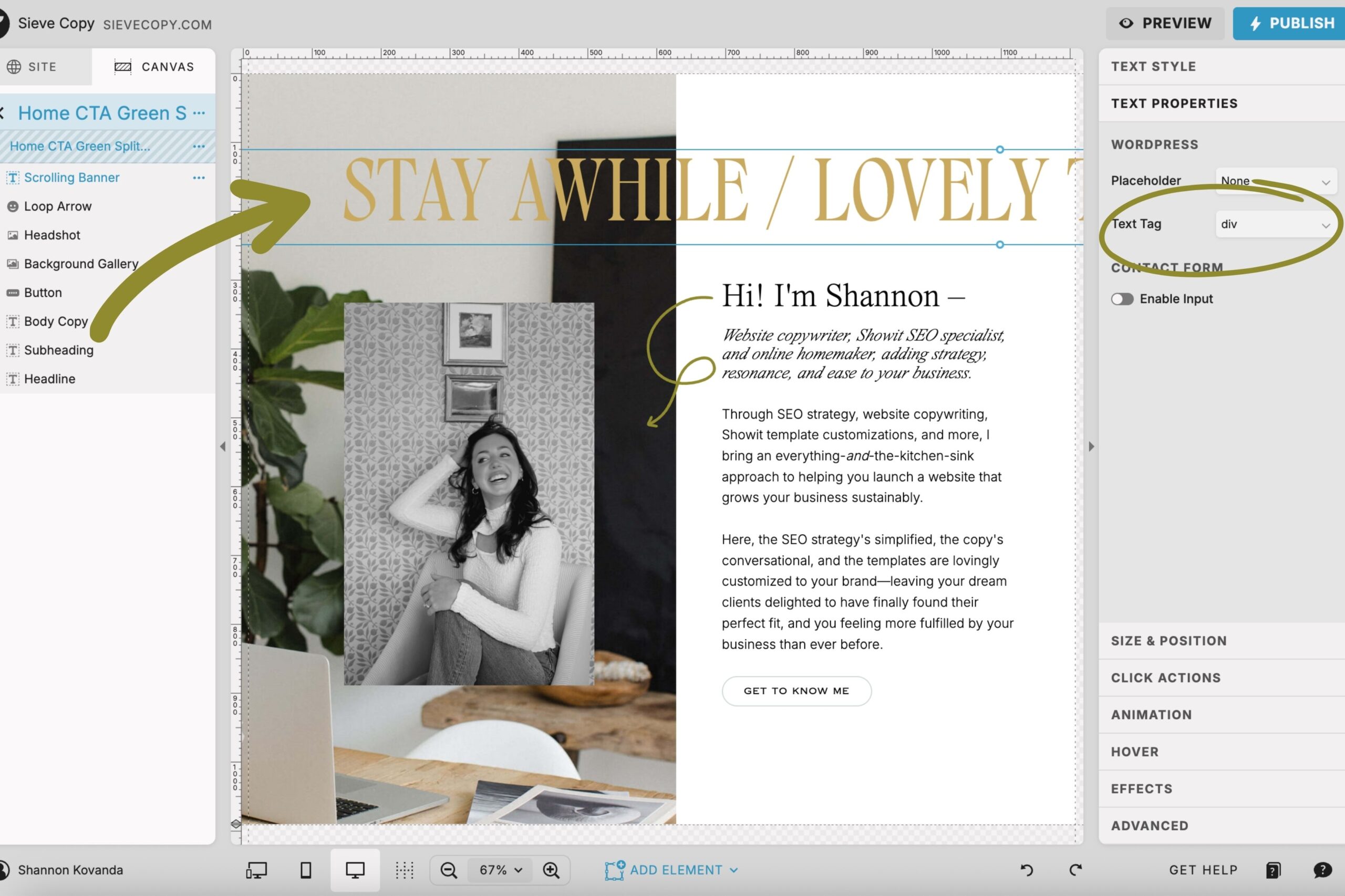
You finally did it. You scaled the mountain that is writing your website copy. It’s no small feat, so you’re happy as heck.
You hit “Publish” with pride… and suddenly your pits are drenched.
“After all that work, what if my copy doesn’t convert?”
“Did I map out each page correctly?”
“Does this answer my ideal client’s questions?”
“Am I saying too much?”
“Am I not saying enough?”
It’s easy to let copy-induced doubts ruin the fun. Especially since almost no one has an ~easy, breezy, beautiful~ time writing about themselves.
Lucky for you, there’s a tried-and-true way to see if your website copy is pulling its weight…
It’s called the copy audit.
So leave your doubts at the door, because I’m giving you a step-by-step guide to performing your own copy audit so you KNOW your words are working for you.
What is a website copy audit and why does it matter?
Before you learn how to audit your website copy, let me tell you about the what and the why.
A website copy audit combs through your website copy, to check for spelling and/or grammar mistakes, to make sure the words on your website flow and function properly, and to make sure your copy speaks directly to your target audience—aka keeps interest and converts.
If a professional website copywriter like myself was auditing your website for you, she would ask questions like:
- Is the tone of voice consistent across the website?
- Does each page have a clear call to action?
- Is it clear what this person is selling/offering?
- Etc. Etc. Etc.
When you know what questions to ask and inconsistencies to look for during an audit, it’s easier to determine whether your website is doing its job.
So, let’s go through the steps you need to take to conduct your own website copy audit.
Step 1. Understand the job of your website.
Here’s a little secret — no matter what your specific goals are for your business, every website has the same objective:
To get your readers to take the next step with you on their journey to becoming a paying client or customer.
Which means your website needs to act as a piece of your sales funnel instead of an online brochure… which really means you need benefits-focused copy that says “here’s how this can help you” instead of “here’s what I do.”
Now that you know the overall goal of your website, you can get more specific about what is the ideal next step your clients should take. In other words, what’s your goal?
Do you want to fill up your calendar with 1:1 client work? Point your audience to your services page for more information on how they can work with you.
Do you sell digital products and market them through your email newsletter? Include opt-ins for your audience to sign up for your email list if they aren’t ready to purchase right now.
Do you run a fitness app with a 7-day free trial? Make sure your readers can easily locate and sign up for the trial period.
You get the idea.
Once you know your goal, it’s time to make sure you understand your ideal client.
Step 2. Really get to know your target audience.
This might make the marketers of yore wag their finger at me in disdain, but I rarely look at demographics when conducting research on a client’s target audience. And I almost never recommend it to my clients.
There are of course exceptions where things like age, gender, or location come into play with messaging (like if you’re a bachelorette weekend planner in Nashville). But I’d bet on the power of psychographics over demographics every time when it comes to really understanding the buying behavior of the people you want to work with.
Psychographics help you understand someone’s wants, needs, motivations, and pain points by studying their emotions, values, habits, attitudes, etc.
And while you’ll have to make some hypotheses about your ideal client’s psychographics, there are many places you can look to gather the information you need to get there. Here are my favorites:
- Comb through your past client testimonials to understand what they were experiencing before you came into their life and how your service changed their situation.
- Take note of common struggles your clients are facing when they reach out to you. If you don’t yet have info to pull from for this, add a question to your intake form asking, “What are you currently experiencing that made you reach out to a [insert your role here] today?” or ask this question directly during discovery calls.
- Read through Google or Amazon reviews of books or products related to your industry.
- Look through your competitors’ social media accounts to see what kind of questions they’re answering with their content.
As you research psychographics for your ideal client or customer, keep track of what you find in a document with four sections:
- Their pain points (what they struggle with)
- Their desires (what they want or need)
- Their doubts (why they might hesitate to become a paying client/customer)
- Their motivations (what would help them confidently move toward purchase)
(Psst–you can also describe your business, your offerings, and your ideal client to ChatGPT and ask it to outline common pain points, desires, doubts, and motivations they might be experiencing in a table for you!)
Once you have a few bullet points for each section, read through your current website to see if your message is resonant to someone experiencing these things.
Step 3. Check for tone, word choice, and writing style consistency.
Now that you have a grip on your message or WHAT you’re trying to say, look at HOW you’re saying it. This includes your tone, word choice, and writing style.
Because maintaining a consistent brand voice is crucial to making your brand recognizable and memorable.
Here are a few things to look out for when auditing how you say what you say:
- Eliminate jargon. You understand your job inside and out. But your audience probably doesn’t know all the industry lingo and jargon you use on a daily basis. Meet your ideal client where they’re at, using plain language and a conversational tone to capture their attention and keep their interest.
- Check for consistent word choice. Do you use the phrase “kickoff call” or “launch call” when referring to the start of your process? Do you prefer “contact” or “inquire”? Do you call yourself a “party planner” or an “event planner”? Comb through your copy for inconsistencies when it comes to your brand’s vocabulary.
- Pay attention to your punctuation. Do you prefer the ellipsis […] over the em dash [—] to show continuation of a thought? Do you use the Oxford comma? Are you totally against exclamation points? Do you use parentheses to add additional commentary and flair?
Your voice is just that—yours. But you have to keep it consistent to make it memorable.
Think about someone whose voice you could recognize anywhere…
Your friend who’s the first to shout “Yasss” in the same tone every time anyone needs a hype woman. Or a coworker with his own unique email sign-off that he never hits ‘Send’ without. Or Matthew McConaughey and his unmistakable “Alright, alright, alright” catchphrase that would make your ears perk up with recognition, even in the noisiest place.
The goal is that if your audience reads your website copy off of an otherwise blank document—no design, no logos, no photos of your face—they’d know it’s yours.
Step 4. Optimize your website for SEO and relevant keywords.
The fact of the matter is that SEO is not something you can afford to ignore. And while this is certainly not a list of everything that contributes to pushing your pages higher in search engine results, there are here’s a quick look at 3 things you need to make sure every core page of your website has:
- A keyword-rich H1 headline.
One of my biggest takeaways from that DIY SEO Course was that websites do not rank, but pages do. So to make sure your pages aren’t competing with one another for the same keyword, select a unique keyword for each page of your site.
Ubersuggest is an easy (& free) way to start identifying keywords that could work for your business. Otherwise, think about what your ideal client might be searching for on Google and incorporate those phrases into your H1 headlines. - A title tag.
A title tag acts as a headline for your page in search engine results. It is how you name your page so the reader knows what that page is about.
An easy formula for writing each page’s title tag is:
“primary keyword, secondary keyword | brand name”
As you can see, you also need to use a keyword or two within your title tags. Here’s a quick checklist on how to write them properly:
- Do no repeat them page to page
- Keep them 50-60 characters in length
- Use title case (capitalize all major words, lowercase all minor words)
- A meta description.
This is the section of text beneath the title tag in a search engine result, describing what’s on the page. And here’s how to write one:
- Describe what the reader will learn on the page
- Use keywords
- Keep them 150-160 characters in length
- Do not repeat them page to page
- Use a call to action to convince the reader to click
And because SEO is so. much. more. than these three components, I offer an SEO Starter Kit service that combines the creative copy aspect of SEO with the technical backend work necessary to getting found on Google.
In conclusion, a website copy audit can help you get higher conversions.
A website copy audit is no small undertaking. But it is one way to fix many of your conversion problems. So if you need someone to take it off your plate, you know where you can find me. 😉
Book a website copy audit and get all these insights & more in a *detailed* Loom video walkthrough complete with a ready-to-implement checklist of action items.
Because you have bigger things to worry about than “Is my website copy doing its job?”
+ view the comments


